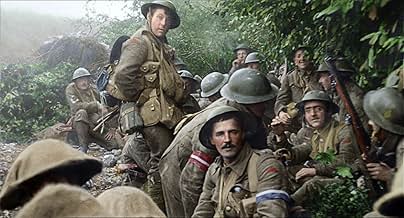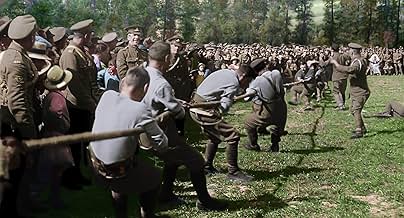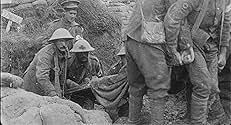CALIFICACIÓN DE IMDb
8.2/10
40 k
TU CALIFICACIÓN
Un documental sobre la Primera Guerra Mundial, con metraje inédito, para conmemorar el centenario de la guerra.Un documental sobre la Primera Guerra Mundial, con metraje inédito, para conmemorar el centenario de la guerra.Un documental sobre la Primera Guerra Mundial, con metraje inédito, para conmemorar el centenario de la guerra.
- Nominada a1 premio BAFTA
- 6 premios ganados y 14 nominaciones en total
Thomas Adlam
- Self - Bedfordshire Regiment
- (voz)
- (as Capt Thomas Adlam VC)
William Argent
- Self - Royal Naval Air Service
- (voz)
- (as LM William Argent)
John Ashby
- Self - The Duke of Cambridge's Own (Middlesex Regiment)
- (voz)
- (as Cpl John Ashby)
Attwood
- Self - British Army
- (voz)
- (as Cpl Attwood)
Walter Aust
- Self - East Yorkshire Regiment
- (voz)
- (as Pte Walter Aust)
Donald Bain
- Self - Seaforth Highlanders
- (voz)
- (as Pte Donald Bain)
Thomas Baker
- Self - Chatham Battalion, Royal Naval Division
- (voz)
- (as Pte Thomas Baker)
George Banton
- Self - 50th Division Headquarters
- (voz)
- (as Sig George Banton)
Walter Becklake
- Self - Northhampyonshire Yeomanry
- (voz)
- (as L Cpl Walter Becklake MM)
Arthur Beeton
- Self - Royal Navy Air Service
- (voz)
- (as POM Arthur Beeton)
Robert Bell
- Self - British Army
- (voz)
- (as Mr Robert Bell)
William Benham
- Self - Hawke Battalion, Royal Navy Division
- (voz)
- (as Sub Lt William Benham)
Joseph Biglin
- Self - Durham Light Infantry
- (voz)
- (as Pte Joseph Biglin)
Edwin Bigwood
- Self - Worcestershire Regiment
- (voz)
- (as Pte Edwin Bigwood)
Horace Birks
- Self - Tanks Corps
- (voz)
- (as Capt Horace Birks)
Edmund Blunden
- Self - Royal Sussex Regiment
- (voz)
- (as Lt Edmund Blunden MC)
Clarence Bourne
- Self - Army Service Corps
- (voz)
- (as S Sgt Clarence Bourne)
Allan Bray
- Self - The Duke of Edinburgh's ((Whiltshire Regiment))
- (voz)
- (as L Cpl Allan Bray)
Opinión destacada
It's only October and I have already seen two Oscar winning films. This (for best documentary) and A star is Born for loads of things.
Months ago I bought a ticket for this special live (3D) screening of this BFI film from the London Film Festival featuring a post film interview between Peter Jackson (the most modest man in cinema) and Mark Kermode (the most adulatory)
I thought it would be special.
It was more than that.
It was a landmark.
It was actually a significant night in cinematic history, because what Peter Jackson has achieved here is unparalleled.
We've all seen colourised war footage. It's interesting, but in reality it's a bit pants.
This is the real deal. A step forward in technology driven by heart, emotion, passion, DNA.
In this truly remarkable documentary Jackson brings us footage from the WW1 front line trenches in a way that you can't even begin to imagine.
First he restored hours of black and white footage to remove grain, scratches, burn marks etc.
Then he graded it.
Then he fixed all the film sprockets so they don't jiggle about and blur.
Then, get this, he turned it all from a hotch-potch of 10/11/12/14/16 and 17 Frames per second into it all being 24 FPS.
This is not insignificant.
A 17 FPS film transferred to 24 frames needs to 'find' 7 frames. It needs to create them, to fill in the gaps to make film flow as we expect. How one does that I have no clue. Frankly, neither does Jackson, but he knows people who were up to it and deliver on the challenge.
So, as Jackson puts it, we don't see Charlie Chaplinesque war footage. We see dignified film of soldiers in real time as our eye would compute it. This is important because it makes it so real.
Then he, frame by frame, colourised the whole lot.
Then he put a team of lip readers onto it to work out what the soldiers were saying when they spoke to camera (in 1914-18 there was no film/sound recording).
Then he recorded both battleground sound effects, by enlisting the NZ army, and the words these soldiers were saying, through actors, and lip synched and background-noised the whole thing.
Then he launched it.
The man is a genius.
The result is beyond words incredible.
On many occasions I gasped out loud, not least when he moved from the first reel, which shows unmodified footage of the preparation of enlistees for WWI, into the reality of war.
In a stunning coup de theatre the screen changes shape.
The audiences audibly gasps.
We are in a new reality.
Now, this all makes it sound like this is simply an exercise in technological show-offery.
No. this focuses on soldiers. Poor. Young. Men.
With terrible teeth, but with opinion, with humour, with dignity, with resolute spirit.
And not just young British men.
Perhaps the most affecting part of this film is where German POW's muck in and join the Brits. It's clear that in those days this was duty and honour for one's country, absolutely NOT hatred of the enemy.
This is a truly remarkable film experience.
It's important.
Find a way of seeing it.
It's much more than a cinematic landmark.
It's a historical one, because the legacy Peter Jackson's 14-18-Now and Imperial War Museum commission gives the world is new technology that will allow all sorts of ancient film archives to become living history.
In this case the 100 minutes that are committed to film are actually backed up by a further 100 hours of monochrome footage that Jackson's team has restored (free of charge) for his commissioners.
See when international honours are handed out (I think Bono has a knighthood for example) Peter Jackson needs to be number one on the list for this real and important achievement.
I assume a further Oscar is in the bag.
Months ago I bought a ticket for this special live (3D) screening of this BFI film from the London Film Festival featuring a post film interview between Peter Jackson (the most modest man in cinema) and Mark Kermode (the most adulatory)
I thought it would be special.
It was more than that.
It was a landmark.
It was actually a significant night in cinematic history, because what Peter Jackson has achieved here is unparalleled.
We've all seen colourised war footage. It's interesting, but in reality it's a bit pants.
This is the real deal. A step forward in technology driven by heart, emotion, passion, DNA.
In this truly remarkable documentary Jackson brings us footage from the WW1 front line trenches in a way that you can't even begin to imagine.
First he restored hours of black and white footage to remove grain, scratches, burn marks etc.
Then he graded it.
Then he fixed all the film sprockets so they don't jiggle about and blur.
Then, get this, he turned it all from a hotch-potch of 10/11/12/14/16 and 17 Frames per second into it all being 24 FPS.
This is not insignificant.
A 17 FPS film transferred to 24 frames needs to 'find' 7 frames. It needs to create them, to fill in the gaps to make film flow as we expect. How one does that I have no clue. Frankly, neither does Jackson, but he knows people who were up to it and deliver on the challenge.
So, as Jackson puts it, we don't see Charlie Chaplinesque war footage. We see dignified film of soldiers in real time as our eye would compute it. This is important because it makes it so real.
Then he, frame by frame, colourised the whole lot.
Then he put a team of lip readers onto it to work out what the soldiers were saying when they spoke to camera (in 1914-18 there was no film/sound recording).
Then he recorded both battleground sound effects, by enlisting the NZ army, and the words these soldiers were saying, through actors, and lip synched and background-noised the whole thing.
Then he launched it.
The man is a genius.
The result is beyond words incredible.
On many occasions I gasped out loud, not least when he moved from the first reel, which shows unmodified footage of the preparation of enlistees for WWI, into the reality of war.
In a stunning coup de theatre the screen changes shape.
The audiences audibly gasps.
We are in a new reality.
Now, this all makes it sound like this is simply an exercise in technological show-offery.
No. this focuses on soldiers. Poor. Young. Men.
With terrible teeth, but with opinion, with humour, with dignity, with resolute spirit.
And not just young British men.
Perhaps the most affecting part of this film is where German POW's muck in and join the Brits. It's clear that in those days this was duty and honour for one's country, absolutely NOT hatred of the enemy.
This is a truly remarkable film experience.
It's important.
Find a way of seeing it.
It's much more than a cinematic landmark.
It's a historical one, because the legacy Peter Jackson's 14-18-Now and Imperial War Museum commission gives the world is new technology that will allow all sorts of ancient film archives to become living history.
In this case the 100 minutes that are committed to film are actually backed up by a further 100 hours of monochrome footage that Jackson's team has restored (free of charge) for his commissioners.
See when international honours are handed out (I think Bono has a knighthood for example) Peter Jackson needs to be number one on the list for this real and important achievement.
I assume a further Oscar is in the bag.
- markgorman
- 22 oct 2018
- Enlace permanente
Argumento
¿Sabías que…?
- TriviaMuch of the footage had never been seen, having sat in the vaults of London's Imperial War Museum for many years.
- ErroresSeveral shots of tanks appear in the film, both Mark V (Mark Five) and Mark V* (Mark Five Star). They have been colourised green. In reality, tanks of these types were painted "a neutral brown colour". See the article by the British Tank Museum which states that. "Surrendering to the inevitable, towards the end of 1916 it was ordered that the tanks should be painted in a 'neutral brown colour' all over." These tanks entered service in 1918, and were factory-painted brown.
- Citas
Soldier: [waving at camera] Hi, mum.
- Créditos curiosos"Filmed on location on the Western Front, 1914 to 1918"
- ConexionesFeatured in Front Row: Episode #3.3 (2018)
Selecciones populares
Inicia sesión para calificar y agrega a la lista de videos para obtener recomendaciones personalizadas
- How long is They Shall Not Grow Old?Con tecnología de Alexa
Detalles
- Fecha de lanzamiento
- Países de origen
- Sitios oficiales
- Idioma
- También se conoce como
- They Shall Not Grow Old
- Locaciones de filmación
- Productoras
- Ver más créditos de la compañía en IMDbPro
Taquilla
- Total en EE. UU. y Canadá
- USD 17,956,913
- Total a nivel mundial
- USD 21,656,913
- Tiempo de ejecución1 hora 39 minutos
- Color
- Mezcla de sonido
- Relación de aspecto
- 1.33 : 1(original footage)
- 1.85 : 1
Contribuir a esta página
Sugiere una edición o agrega el contenido que falta

Principales brechas de datos
What is the Hindi language plot outline for Jamás llegarán a viejos (2018)?
Responda






